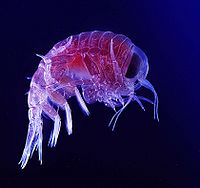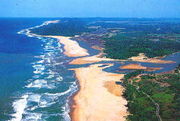Plankton

Plankton are any drifting organisms (animals, plants, archaea, or bacteria) that inhabit the pelagic zone of oceans, seas, or bodies of fresh water. Plankton are defined by their ecological niche rather than phylogenetic or taxonomic classification. They provide a crucial source of food to larger, more familiar aquatic organisms such as fish and cetacea.
Though many planktic (or planktonic—see section on Terminology) species are microscopic in size, plankton includes organisms covering a wide range of sizes, including large organisms such as jellyfish.
Contents |
Terminology

The name plankton is derived from the Greek adjective πλαγκτός - planktos, meaning "errant", and by extension "wanderer" or "drifter".[1] Plankton typically flow with ocean currents. While some forms are capable of independent movement and can swim hundreds of meters vertically in a single day (a behavior called diel vertical migration), their horizontal position is primarily determined by the surrounding currents. This is in contrast to nekton organisms that can swim against the ambient flow and control their position (e.g. squid, fish, and marine mammals).
Within the plankton, holoplankton spend their entire life cycle as plankton (e.g. most algae, copepods, salps, and some jellyfish). By contrast, meroplankton are only planktic for part of their lives (usually the larval stage), and then graduate to either a nektic or benthic (sea floor) existence. Examples of meroplankton include the larvae of sea urchins, starfish, crustaceans, marine worms, and most fish.
Plankton abundance and distribution are strongly dependent on factors such as ambient nutrients concentrations, the physical state of the water column, and the abundance of other plankton.
The study of plankton is termed planktology and individual plankton are referred to as plankters.
The widespread use of planktonic in both scientific and popular literature is grammatically incorrect because of the Greek roots of plankton. When deriving English words from their Greek or Latin roots the gender specific ending (in this case "-on", which indicates the word is neuter) is dropped, using only the root of the word in the derivation. The less commonly used planktic is the correct adjective.[2]
Trophic groups

Plankton are primarily divided into broad functional (or trophic level) groups:
- Phytoplankton (from Greek phyton, or plant), autotrophic, prokaryotic or eukaryotic algae that live near the water surface where there is sufficient light to support photosynthesis. Among the more important groups are the diatoms, cyanobacteria, dinoflagellates and coccolithophores.
- Zooplankton (from Greek zoon, or animal), small protozoans or metazoans (e.g. crustaceans and other animals) that feed on other plankton and telonemia. Some of the eggs and larvae of larger animals, such as fish, crustaceans, and annelids, are included here.
- Bacterioplankton, bacteria and archaea, which play an important role in remineralising organic material down the water column (note that the prokaryotic phytoplankton are also bacterioplankton).
This scheme divides the plankton community into broad producer, consumer and recycler groups. However, determining the trophic level of some plankton is not straightforward. For example, although most dinoflagellates are either photosynthetic producers or heterotrophic consumers, many species are mixotrophic depending upon circumstances.
Size groups
Plankton are also often described in terms of size.[3] Usually the following divisions are used:
| Group | Size range (ESD) | ||
| Megaplankton | > 2×10−2 m | (20+ mm) | metazoans; e.g. jellyfish; ctenophores; salps and pyrosomes (pelagic Tunicata); Cephalopoda |
| Macroplankton | 2×10−3→2×10−2 m | (2–20 mm) | metazoans; e.g. Pteropods; Chaetognaths; Euphausiacea (krill); Medusae; ctenophores; salps, doliolids and pyrosomes (pelagic Tunicata); Cephalopoda |
| Mesoplankton | 2×10−4→2×10−3 m | (0.2 mm-2 mm) | metazoans; e.g. copepods; Medusae; Cladocera; Ostracoda; Chaetognaths; Pteropods; Tunicata; Heteropoda |
| Microplankton | 2×10−5→2×10−4 m | (20-200 µm) | large eukaryotic protists; most phytoplankton; Protozoa (Foraminifera); ciliates; Rotifera; juvenile metazoans - Crustacea (copepod nauplii) |
| Nanoplankton | 2×10−6→2×10−5 m | (2-20 µm) | small eukaryotic protists; Small Diatoms; Small Flagellates; Pyrrophyta; Chrysophyta; Chlorophyta; Xanthophyta |
| Picoplankton | 2×10−7→2×10−6 m | (0.2-2 µm) | small eukaryotic protists; bacteria; Chrysophyta |
| Femtoplankton | < 2×10−7 m | (< 0.2 µm) | marine viruses |
However, some of these terms may be used with very different boundaries, especially on the larger end of the scale.
The existence and importance of nano- and even smaller plankton was only discovered during the 1980s, but they are thought to make up the largest proportion of all plankton in number and diversity.
The microplankton and smaller groups are microorganisms and operate at low Reynolds numbers, where the viscosity of water is much more important than its mass or inertia. [4]
Distribution
Plankton inhabit oceans, seas and lakes. Local abundance varies horizontally, vertically and seasonally. The primary cause of this variability is the availability of light. All plankton ecosystems are driven by the input of solar energy (but see chemosynthesis), confining primary production to surface waters, and to geographical regions and seasons having abundant light.
A secondary variable is nutrient availability. Although large areas of the tropical and sub-tropical oceans have abundant light, they experience relatively low primary production because they offer limited nutrients such as nitrate, phosphate and silicate. This results from large-scale ocean circulation and water column stratification. In such regions, primary production usually occurs at greater depth, although at a reduced level (because of reduced light).
Despite significant macronutrient concentrations, some ocean regions are unproductive (so-called HNLC regions)[5]. The micronutrient iron is deficient in these regions, and adding it can lead to the formation of blooms of many kinds of phytoplankton[6]. Iron primarily reaches the ocean through the deposition of dust on the sea surface. Paradoxically, oceanic areas adjacent to unproductive, arid land thus typically have abundant phytoplankton (e.g., the western Atlantic Ocean, where trade winds bring dust from the Sahara Desert in north Africa). While plankton are most abundant in surface waters, they live throughout the water column. At depths where no primary production occurs, zooplankton and bacterioplankton instead consume organic material sinking from more productive surface waters above. This flux of sinking material, so-called marine snow, can be especially high following the termination of spring blooms.
Biogeochemical significance
Aside from representing the bottom few levels of a food chain that supports commercially important fisheries, plankton ecosystems play a role in the biogeochemical cycles of many important chemical elements, including the ocean's carbon cycle.
Primarily by grazing on phytoplankton, zooplankton provide carbon to the planktic foodweb, either respiring it to provide metabolic energy, or upon death as biomass or detritus. Typically more dense than seawater, organic material tends to sink. In open ocean ecosystems away from the coasts this transports carbon from surface waters to the deep. This process is known as the biological pump, and is one reason that oceans constitute the largest carbon sink on Earth.
It might be possible to increase the ocean's uptake of carbon dioxide generated through human activities by increasing plankton production through "seeding", primarily with the micronutrient iron. However, this technique may not be practical at a large scale. Ocean oxygen depletion and resultant methane production (caused by the excess production remineralising at depth) is one potential drawback.[7][8]
Population decline
A 2010 study reported a 40 percent reduction in worldwide phytoplankton levels since the 1950s. The report attributes the decline to increasing surface ocean temperatures, which makes it hard for phytoplankton to acquire nutrients.
Phytoplankton levels across the world's oceans started to drop in the 1950s. The biggest changes are in the Arctic, southern and equatorial Atlantic and equatorial Pacific oceans, with only Indian Ocean levels remaining stable. Phytoplankton levels temporarily plummet during El Nino periods, killing many sea birds and marine mammals.
According to lead author Daniel Boyce, "Much of the oxygen in our atmosphere today was produced by phytoplankton or phytoplankton precursors over the past 2 billion years." Like all plants, phytoplankton produce oxygen by reducing carbon dioxide (CO2) from the air.
Previous plankton research has mostly relied on satellite data that has been collected since 1978. This study instead analyzed data which has been collected from Secchi disks since 1899. These disks measure turbidity, which increases with plankton density.[9]
 An amphipod, Photo of exoskeletoned animal with curved body, with two long and two short antenna. |
 A copepod (Calanoida sp.) ca. 1-2 mm long, Photo of translucent ovoid animal with two long antennae |
 Siphonophora – the "conveyor belt" of the upgrowing larvae and the ovarium can be seen |
 Sea foam is produced by plankton, Photo of many, differently sized bubbles with image of man |
Importance to fish
Zooplankton are the initial prey item for almost all fish larvae as they switch from their yolk sacs to external feeding. Fish rely on the density and distribution of zooplankton to match that of new larvae, which can otherwise starve. Natural factors (e.g., current variations) and man-made factors (e.g. river dams) can strongly affect zooplankton, which can in turn strongly affect larval survival, and therefore breeding success.
See also
- Aeroplankton
- Algal bloom
- Biological pump
- Gelatinous zooplankton
- Holoplankton
- Iron fertilization
- Meroplankton
- Nekton
- Ocean acidification
- Paradox of the plankton
- Phytoplankton
- Primary production
- Zooplankton
References
- ↑ Thurman, H. V. (1997). Introductory Oceanography. New Jersey, USA: Prentice Hall College. ISBN 0132620723.
- ↑ Emiliani, C. (1991). "Planktic/Planktonic, Nektic/Nektonic, Benthic/Benthonic". Journal of Paleontology (Journal of Paleontology, Vol. 65, No. 2) 65 (2): 329. http://www.jstor.org/stable/1305769.
- ↑ Omori, M.; Ikeda, T. (1992). Methods in Marine Zooplankton Ecology. Malabar, USA: Krieger Publishing Company. ISBN 0-89464-653-2.
- ↑ Dusenbery, David B. (2009). Living at micro scale: the unexpected physics of being small. Cambridge: Harvard University Press. ISBN 0-674-03116-4.
- ↑ Martin, J. H.; Fitzwater, S. E. (1988). "Iron-deficiency limits phytoplankton growth in the Northeast Pacific Subarctic". Nature 331: 341–343. doi:10.1038/331341a0.
- ↑ Boyd, P.W., et al.; Watson, AJ; Law, CS; Abraham, ER; Trull, T; Murdoch, R; Bakker, DC; Bowie, AR et al. (2000). "A mesoscale phytoplankton bloom in the polar Southern Ocean stimulated by fertilization". Nature 407 (6805): 695–702. doi:10.1038/35037500. PMID 11048709.
- ↑ Chisholm, S.W., et al.; Falkowski, PG; Cullen, JJ (2001). "Dis-crediting ocean fertilization". Science 294 (5541): 309–310. doi:10.1126/science.1065349. PMID 11598285.
- ↑ Aumont, O.; Bopp, L. (2006). "Globalizing results from ocean in situ iron fertilization studies". Global Biogeochemical Cycles 20 (2): GB2017. doi:10.1029/2005GB002591. http://www.agu.org/pubs/crossref/2006/2005GB002591.shtml.
- ↑ Borenstein, Seth (July 28, 2010). "Plankton, base of ocean food web, in big decline". http://news.yahoo.com/s/ap/20100728/ap_on_sc/us_sci_declining_plankton. Retrieved August 2010.
Further reading
- Dusenbery, David B. (2009). Living at Micro Scale: The Unexpected Physics of Being Small. Harvard University Press, Cambridge, Mass. ISBN 978-0-674-03116-6.
- Kiørboe, Thomas (2008). A Mechanistic Approach to Plankton Ecology. Princeton University Press, Princeton, N.J. ISBN 978-0-691-13422-2.
External links
- COPEPOD: The global plankton database, global coverage database of zooplankton biomass and abundance data
- Plankton*Net, taxonomic database of images of plankton species
- Guide to the marine zooplankton of south eastern Australia, Tasmanian Aquaculture and Fisheries Institute
- Sir Alister Hardy Foundation for Ocean Science - Continuous Plankton Recorder Survey
- Australian Continuous Plankton Recorder Project, Integrated Marine Observing System
- Dr Richard Kirby (February 5, 2010). "Audio slideshow: Sea drifters". BBC News. http://news.bbc.co.uk/1/hi/sci/tech/8498786.stm.
|
|||||||||||||||||||||||||||||||||||
|
||||||||||||||||||||||||||||||

